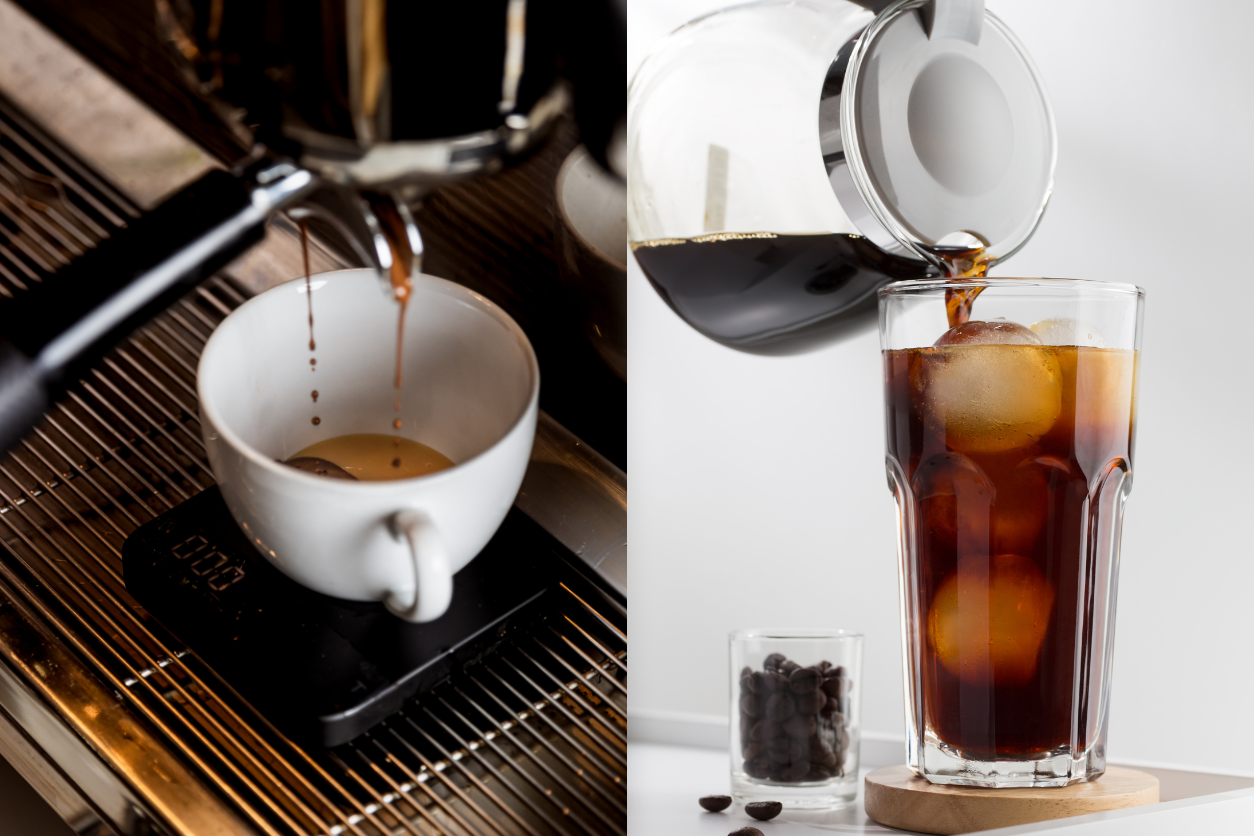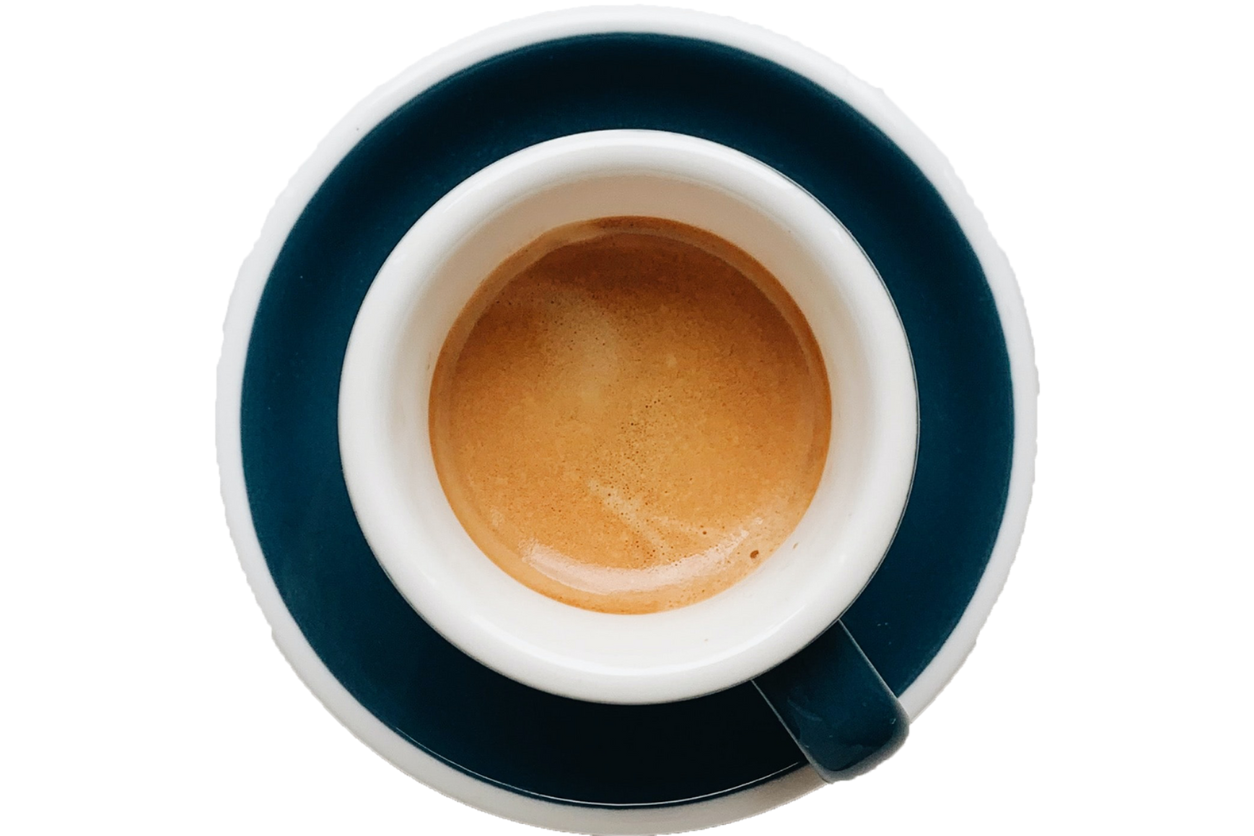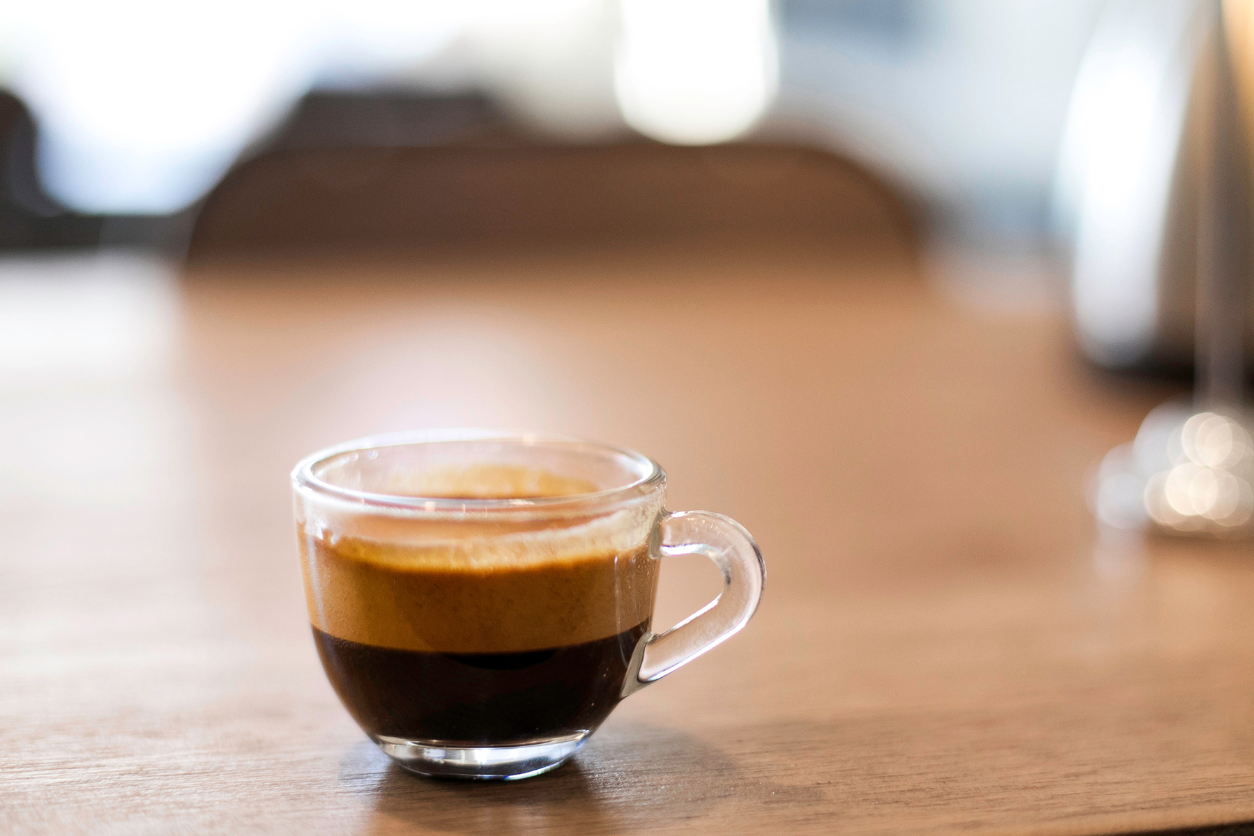How Is Espresso Different From Regular Coffee?

Same beans, same grind, but different brewing methods. Let’s find out which one tastes better: espresso or coffee?
If you’ve ever sipped on an espresso shot and then followed it up with a cup of regular coffee, you’ll know that the difference is undeniable. The intense flavor of the espresso really makes it stand out as a unique experience. Coffee enthusiasts might already have a sense of what sets espresso apart from regular coffee, but for those who don’t, here’s how the two stack up in terms of taste, brewing, and even caffeine level.
What Is Espresso?

At its core, espresso is simply a method of brewing coffee. But it’s the intense concentration of flavor and the process involved that gives espresso its distinct personality. The term “espresso” often conjures up images of small, strong shots of coffee served in tiny cups, but the key distinction isn’t just in the serving size—it’s in the way it’s made.
Espresso is brewed by forcing hot water through finely-ground coffee beans under high pressure. This process extracts a concentrated coffee shot with a richer, more robust flavor profile than what you typically get from a regular cup of coffee. The use of pressure is what defines espresso and creates that signature crema—the creamy layer that forms on top of a well-pulled shot.
How Is It Brewed?
One of the defining features of espresso is the pressure used during the brewing process. A typical espresso machine uses around 9 bars of pressure—roughly nine times the atmospheric pressure at sea level—to push hot water through the coffee grounds. The high pressure extracts a dense, rich coffee with a unique body and flavor that stands out in the espresso vs coffee debate. Conversely, a semi-automatic espresso maker uses about 20 bars of pressure for even greater flavor extraction.
With regular coffee, the brewing process is much less intense. The water either drips slowly through the grounds, as with a drip coffee maker, or the coffee grounds are steeped in hot water, as with a French press. Without the high pressure, regular coffee lacks the same intensity, but it often has more subtle, nuanced flavors that come from a longer brewing time.
And is it better than regular coffee? We’ll let Sabrina Carpenter answer that question:
How Is Regular Coffee Brewed?
Regular coffee, whether freshly brewed or boxed coffee, uses a more leisurely brewing method. There are plenty of ways to make it—drip machine, French press, Aeropress, you name it. But the main difference is how the water interacts with the coffee grounds. Instead of high pressure, gravity does all the work to extract the flavors from the beans.
The result is a milder, more diluted brew compared to the intensity of espresso. The flavors in regular coffee are typically more mellow, and because it’s brewed over a longer period of time, the drink is often less concentrated, making it easier to sip over a long morning or afternoon.
| Type of Coffee | Taste/Notes | Brewing Method | Grind | Caffeine Level (per 8 oz) |
| Espresso | Bold, rich, concentrated, with crema; sometimes sweet or bittersweet | High pressure extraction using an espresso machine | Finely ground (almost powder-like) | 63-80 mg (per 1 oz shot) |
| Drip Coffee | Balanced, smooth, less intense, with subtle flavors depending on the bean | Hot water slowly filters through medium-ground beans using a drip machine | Medium ground (similar to table salt) | 95-200 mg |
| French Press | Full-bodied, slightly gritty, robust flavor due to immersion brewing | Grounds steep in hot water for several minutes, then pressed using a plunger | Coarse ground (chunky, like sea salt) | 80-100 mg |
| Pour Over | Clean, crisp, smooth, and highlights the bean’s delicate notes | Hot water poured over coffee grounds in a filter, typically using a gooseneck kettle | Medium-fine ground (slightly finer than drip coffee) | 95-165 mg |
| Cold Brew | Smooth, less acidic, often described as naturally sweet or chocolatey | Coffee grounds steep in cold water for 12-24 hours, then strained | Coarse ground (similar to French press grind) | 100-200 mg (depending on brew time and strength) |
| Moka Pot | Strong, rich, somewhat similar to espresso but less intense, often bold and nutty | Steam pressure pushes water through finely ground coffee in a stovetop moka pot | Fine ground (similar to espresso grind but slightly coarser) | 105-120 mg |
Espresso vs Coffee: The Main Differences
Grind Size
Espresso requires finely ground coffee beans, almost powder-like because the high-pressure brewing method requires a tight, compact coffee bed for that to be perfect. The fine grind helps maximize surface area, allowing for quicker extraction of the coffee’s essential oils, flavors, and aromas.
Regular coffee, on the other hand, uses a coarser grind. The coarser the grind, the slower the extraction, which is ideal for brewing methods like drip coffee or French press that don’t rely on pressure. A too-fine grind in these methods can lead to over-extraction, resulting in a bitter cup of coffee.
Flavor Profile
If you’ve ever tasted espresso and regular coffee side by side, the difference is clear. Espresso is bold, rich, and full-bodied. Its flavor is more concentrated, giving you a punch of coffee in just a single shot. The crema on top adds a velvety texture that enhances the overall drinking experience.
Regular coffee, by comparison, tends to have a lighter body and a more complex flavor profile, especially when brewed with high-quality beans. Since it’s brewed at a lower pressure and for a longer time, more of the subtle flavors from the beans have a chance to develop, resulting in a smoother, sometimes more nuanced drink.
Caffeine Content
It’s a common misconception that espresso contains more caffeine than regular coffee. While espresso is indeed stronger in flavor and more concentrated, a single shot (about 1 ounce) typically contains less caffeine than a standard 8-ounce cup of drip coffee.
However, since espresso is served in much smaller portions, you may end up drinking less caffeine per serving. On average, a shot of espresso contains around 63 milligrams of caffeine, while a regular 8-ounce cup of coffee can contain anywhere from 95 to 200 milligrams, depending on the brew strength.
Serving Size
Another difference between espresso and regular coffee is how they’re typically enjoyed. Espresso is usually served in small portions, often just 1 to 2 ounces, making it a quick, intense burst of coffee that’s often consumed in a matter of minutes. It’s common to see people in Europe standing at a café bar, downing their espresso shots quickly before getting on with their day.
Regular coffee, on the other hand, is more of a leisurely drink. Whether you’re sipping on a large mug in the morning or nursing a cup throughout the day, regular coffee lends itself to longer, more relaxed drinking sessions. It’s often associated with breakfast or mid-day breaks, giving you time to savor each sip.
Versatility
Espresso serves as the base for many popular coffee drinks like lattes, cappuccinos, macchiatos and Americanos. The concentrated flavor of espresso means it holds up well when combined with steamed milk or creamer, creating a wide range of beverages that can be enjoyed hot or iced.
Regular coffee, while less versatile in terms of fancy café drinks, still has its own appeal. It’s the foundation of countless morning routines and can be enjoyed black or with a splash of milk, cream, or sugar. For those who like to keep things simple, regular coffee offers endless possibilities for customization without the need for an espresso machine.
Crema

One of the most distinguishing features of espresso is the crema—the thick, golden foam that sits on top of a freshly pulled shot. Crema is created during the high-pressure extraction process, as water and air are forced through the coffee grounds, releasing tiny bubbles of carbon dioxide. This layer of foam not only looks beautiful but also adds a creamy texture and subtle sweetness to the espresso.
In contrast, regular coffee doesn’t develop crema because it isn’t brewed under pressure. While this doesn’t detract from the experience of drinking regular coffee, the absence of crema is a visual and textural difference that sets espresso apart in the espresso vs coffee discussion.
Our Recipe for Trust: Why Choose Kitchen Institute
At the Kitchen Institute, we're dedicated to providing reliable and accurate information on cooking trends, tips, and product reviews. Our team of passionate food enthusiasts ensures that every piece of content is thoroughly researched and based on real-world experience. We pride ourselves on our comprehensive and unbiased product reviews, rigorous research processes, and commitment to staying current with the latest culinary innovations. Trust us to enhance your culinary journey with quality insights and practical advice.